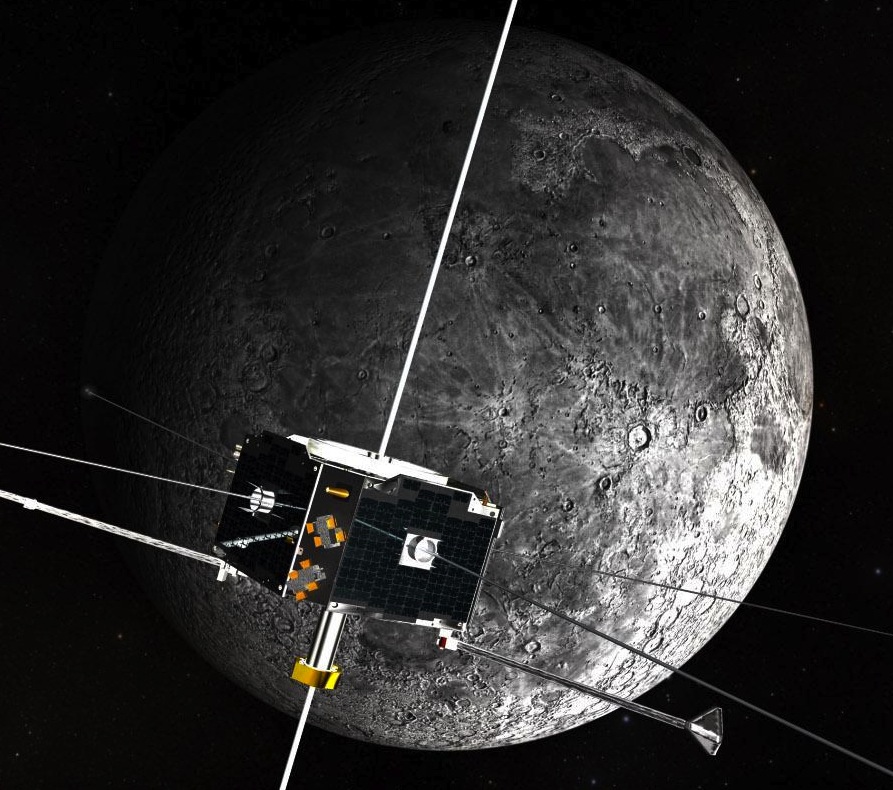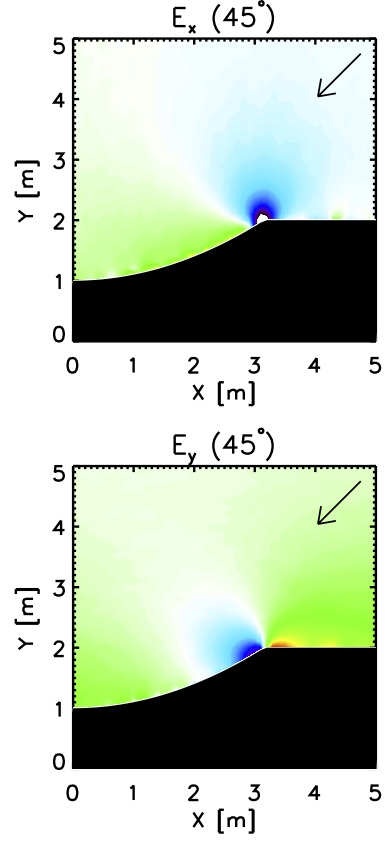-

An image of one of the ARTEMIS spacecraft in orbit around the Moon. [NASA/SSL]
-

A slice of the x- and y-components of the electric field from a 3-dimensional particle-in-cell simulation of the plasma environment above a lunar crater.
My research
The main focus of my research involves plasma interaction with non-magnetized bodies in the solar system. We can group objects in the solar system by whether or not they have a global magnetic field to shield them from external plasmas. Mercury, Earth and Jupiter are all examples of bodies that are protected by large, global magnetic fields. My research, on the other hand, focuses on objects whose surfaces are not protected from the solar wind and other plasmas, such as Earth's Moon, the moons of Mars, and the moons of Jupiter and Saturn.
My research at SSL is part of a broader framework for understanding the plasma and neutral environment at the Moon; namely, the Dynamic Response of the Environments at Asteroids, the Moon, and the moons of Mars (DREAM2) node of the NASA Solar System Exploration Research Virtual Institute (formerly the NASA Lunar Science Institute).
Some of my research with the ARTEMIS mission has been highlighted as science "nuggets":
- ARTEMIS observations of molecular ions escaping from the terrestrial ionosphere down the magnetotail and past the Moon;
- A study using LADEE/LDEX observations of pickup ions and ARTEMIS solar wind monitoring to understand the variability of lunar pickup ion production rates;
- A study of diamagnetic fields in the lunar wake observed by ARTEMIS that exceeded 250 percent of the ambient, undisturbed IMF strength;
- A comparison of ARTEMIS observations of lunar pickup ions in the terrestrial magnetotail lobes with a particle model in an effort to constrain the neutral density of various species in the lunar exosphere;
- A description of novel measurements by ARTEMIS of pickup ions in the terrestrial magnetotail lobes generated via photoionization of the neutral lunar exosphere;
The ARTEMIS mission continues to successfully gather lots (and lots!) of data regarding the lunar-plasma interaction, with many more discoveries waiting to happen.
My research in graduate school at the University of Colorado at Boulder consisted of a few main projects:
- The Student Dust Counter (SDC) on the New Horizons mission. SDC is an entirely student-built and operated instrument that measures a signal when a dust grain impacts one of its 12 detectors. The rate at which these tiny grains strike the instrument as New Horizons voyages to Pluto can tell us the density of dust in the solar system, and from that, we can infer characteristics of the Kuiper Belt, a cold, dark, icy belt of asteroids out past of the orbit of Neptune.
- The Cosmic Dust Experiment (CDE) on the Aeronomy of Ice in the Mesosphere mission. CDE is a near-identical replica of SDC, but in Earth-orbit where it measures the rate at which dust grains enter the Earth and burn up in its upper atmosphere. This input of cosmic dust into Earth's atmosphere is important as it's thought to be a critical component in the formation and variability of Polar Mesospheric Clouds (PMC).
- Modeling the lunar dusty plasma environment. This project was the topic of my thesis and was most of what I spent my time in graduate school working on. In short, several experiments from the Apollo missions gave us an outline of what the plasma and dust environment was like on the surface on the Moon, but forty years later, we still have an incomplete understanding. I helped to fill in these blanks by making computer models using the laws of physics to help explore what occurs above the surface of the Moon. In the end, NASA will need to build instruments and send them to the Moon to verify these, and many other models, but for now, it helps to at least have an idea about what's most likely going on. Most of this work was under the umbrella of the Colorado Center for Lunar Dust and Atmospheric Studies, one of seven nodes of the NASA Lunar Science Institute.
See my CV.
